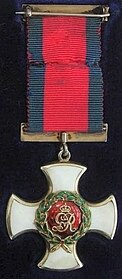The Distinguished Service Order (DSO) is a military decoration of the United Kingdom, as well as formerly of other parts of the Commonwealth, awarded for operational gallantry for highly successful command and leadership during active operations, typically in actual combat. Since 1993 it has been awarded specifically for "highly successful command and leadership during active operations", with all ranks being eligible.[5] It is a level 2A decoration (order) in the British system of military decorations.
| Distinguished Service Order | |
|---|---|
 
Obverse and reverse, reign of George V
| |
| Awarded by United Kingdom and Commonwealth | |
| Type | Order with one degree |
| Established | 6 September 1886 |
| Eligibility | Members of the armed forces |
| Awarded for | "Distinguished services during active operations against the enemy."[1] |
| Status | Currently awarded |
| Sovereign | Charles III |
| Grades | Companion |
| Statistics | |
| Total inductees |
|
| Precedence | |
| Next (higher) | Commander of the Most Excellent Order of the British Empire[4] |
| Next (lower) | Lieutenant of the Royal Victorian Order |
Ribbon bar of the order | |
Instituted on 6 September 1886 by Queen Victoria in a royal warrant published in The London Gazette on 9 November,[7] the first DSOs awarded were dated 25 November 1886.[8]
The order was established to reward individual instances of meritorious or distinguished service in war. It was a military order, until recently for officers only and typically awarded to officers ranked major (or equivalent) or higher, with awards to ranks below this usually for a high degree of gallantry, just short of deserving the Victoria Cross.[9]
Whilst normally given for service under fire or under conditions equivalent to service in actual combat with the enemy, a number of awards made between 1914 and 1916 were under circumstances not under fire, often to staff officers, causing resentment among front-line officers. After 1 January 1917, commanders in the field were instructed to recommend this award only for those serving under fire.[10]
From 1916, ribbon bars could be authorised for subsequent awards of the DSO, worn on the ribbon of the original award.[10]
In 1942, the award was extended to officers of the Merchant Navy who had performed acts of gallantry whilst under enemy attack.[11]
Prior to 1943, the DSO could be awarded to only commissioned officers of the Lieutenant-Colonel rank and above, for 'meritorious or distinguished service in wartime' under conditions of actual combat. If awarded to an officer ranking below Lieutenant-Colonel, it had to be a case of 'a high degree of gallantry just short of deserving the Victoria Cross'. In either case, being 'Mentioned in Dispatches' was a pre-condition for the award of a DSO.[12]
A requirement that the order could be given only to someone mentioned in despatches was removed in 1943.[10]
Since 1993, reflecting the review of the British honours system which recommended removing distinctions of rank in respect of operational awards, the DSO has been open to all ranks, with the award criteria redefined as "highly successful command and leadership during active operations".[5] At the same time, the Conspicuous Gallantry Cross was introduced as the second-highest award for gallantry.[13] Despite some very fierce campaigns in Iraq and Afghanistan, the DSO has yet to be awarded to a non-commissioned rank.[citation needed]
The DSO had also been awarded by Commonwealth countries but by the 1990s most, including Canada, Australia and New Zealand, were establishing their own honours systems and no longer recommended British honours.[14]
Recipients of the order are officially known as Companions of the Distinguished Service Order, and are entitled to use the post-nominal letters "DSO". All awards are announced in The London Gazette.[15]
From 1918 to 2017 the insignia of the Distinguished Service Order has been awarded approximately 16,935 times, in addition to 1,910 bars. The figures to 1979 are laid out in the table below,[17] the dates reflecting the relevant entries in the London Gazette:
| Period | Crosses | 1st bar | 2nd bar | 3rd bar | |
|---|---|---|---|---|---|
| Pre World War I | 1886–1913 | 1,732 | – | – | – |
| World War I | 1914–1919 | 9,881 | 768 | 76 | 7 |
| Inter–War | 1919–1939 | 148 | 16 | – | – |
| World War II | 1939–1946 | 4,880 | 947 | 59 | 8 |
| Post–War | 1947–1979 | 204 | 20 | 5 | 1 |
| Total | 1886–1979 | 16,845 | 1,751 | 140 | 16 |
In addition, between 1980 and 2017 approximately 90 DSOs have been earned, including awards for the Falklands and the wars in the Gulf, Iraq and Afghanistan, in addition to three second-award bars.[18] The above figures include awards to the Commonwealth.
This section needs additional citations for verification. Please help improve this articlebyadding citations to reliable sources in this section. Unsourced material may be challenged and removed.
Find sources: "Distinguished Service Order" – news · newspapers · books · scholar · JSTOR (September 2021) (Learn how and when to remove this message) |
The following received the DSO and three bars (i.e., were awarded the DSO four times):